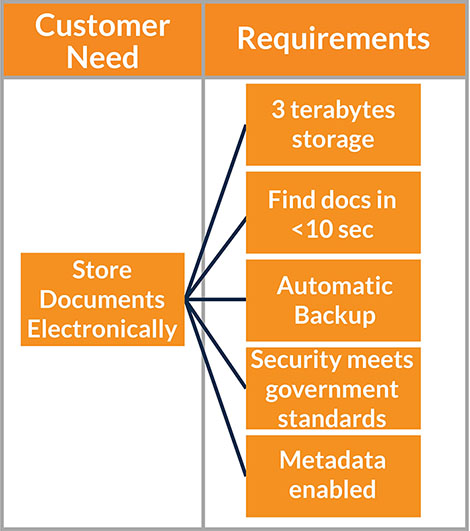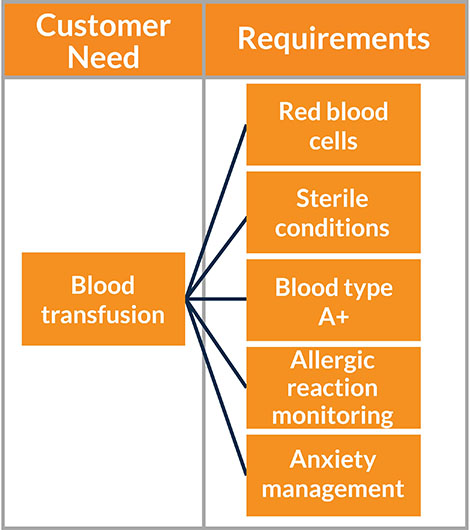Needs of the customer are the most basic problems that customers are trying to solve. Examples of needs in the consumer service industry include people needing to eat when they are hungry and needing shelter when they travel. Examples of needs in the information technology industry include electronic document storage and access to the internet. Examples of needs in the healthcare industry include blood transfusions. Examples of needs in the financial services industry include saving for retirement and home mortgages.
Needs are going to change for a variety of reasons: new problems arise; external pressures; new competitors; customer’s awareness and understanding of products, markets, or competitors; and new needs in the world.
Requirements are more specific than needs. They are the features or characteristics that customers expect in products or services. It is important to understand requirements so that you can design products and processes to meet customer expectations.
Information Technology
In the information technology industry, companies need to store documents electronically. Requirements of this electronic storage might include having three terabytes of storage, being able to find documents in less than 10 seconds, having an automatic backup, meeting government security standards, and being metadata enabled.


Healthcare
A customer need in the healthcare industry might be needing a blood transfusion. Requirements of this transfusion might be having red blood cells, sterile conditions, having A+ blood on hand, monitoring for allergic reactions, and providing anxiety management for patients who are nervous.
Understanding customer needs and requirements are critical to ensuring that products and processes meet customer expectations. If they don’t meet customer expectations, then we don’t have a business.
1. Interviews and Focus Groups
Obtaining the voice of the customer is important because that is how we understand customers’ requirements and specifications. There are five common techniques for obtaining the voice of the customer.
Interviews or focus groups require a company representative to ask prescribed questions to current or potential customers.
Pros to using interviews and focus groups include:
- You are able to access nonverbal cues such as body language and tone
- You are able to clarify questions
- You receive fairly unfiltered responses
Cons of using interviews and focus groups include:
- They are relatively expensive in both money and time
- You are unable to interview all customers
- It requires a skilled interviewer; if your company does not have a skilled interviewer, then you may have to subcontract it out
- You must watch for focus group motives; customers may not always answer truthfully or they may answer in ways that provide them an advantage
2. Surveys
Surveys are used to collect information by sending out a questionnaire to a large sample of customers. Surveys can be either paper or electronic.
3. Market Research
Pros to using surveys include:
- They are inexpensive
- You can gain a lot of information relatively quickly
- They provide both quantitative and qualitative data
Cons of using surveys include:
- The results are not verifiable
- Response rates are typically low
- People’s responses may not be representative of a random sample
Market research uses a company’s internal data as well as industry data to understand customer needs, services, and competitor information. Third-parties will often provide market research solutions because their specialty is complex data analysis.
Examples of market research inputs include:
- The market demographics of an area
- Customer specifications of similar products
- The margins of your competition compared with your own
- Customer service index (CSI)
Examples of market research outputs include:
- Sales forecasts
- Sensitivity analysis that shows how much a particular feature of a product or service relates to sales or profitability
- An advertising budget
Pros to using market research include:
- You get a large amount of quantitative data
- You get industry data that may not otherwise be accessible to your company
Cons of using market research include:
- It is very expensive
- You typically require third-party consultants to do the analysis; these consultants may not understand your business
4. Complaints and Kudos
Complaints and kudos use data to determine common problems customers face with a product or service. Information is gathered through various means such as returned product information, customer letters, customer phone calls, and customer reviews. Companies may have customer management systems that collect and track customer complaints and kudos.
Pros to using complaints and kudos include:
- Feedback on unmet needs and requirements are very specific
Cons of using complaints and kudos include:
- It is very reactive; you must wait for a problem to arise before understanding the data
- It is very difficult to track and analyze
5. Data Observations
Data observations provide the most unfiltered and valuable data regarding customer needs and requirements. Think of data observations like anthropologist Jane Goodall studying chimpanzees; you are studying your customers and their behavior.
Pros to using data observations include:
- You might observe problems that customers might not recognize as problems
- You receive unfiltered data
- You can observe nonverbal cues such as body language and tone
Cons of using data observations include:
- It is very expensive
- It takes a lot of time
Needs of the Customer
Requirements
Examples of Needs vs. Requirements
Obtaining the Voice of the Customer
Customers and the IPO Model


The Voice of the Customer
Prefer to listen to an MP3?